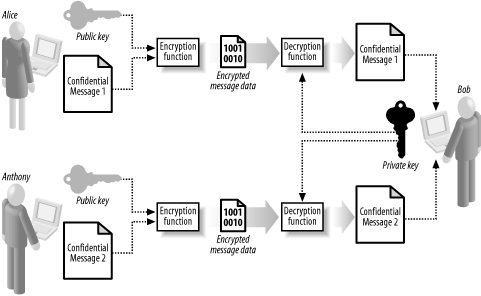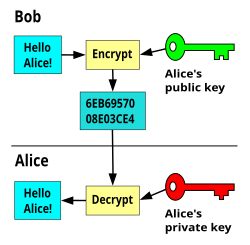How Asymetric Public Private Key Pairs Are Generated
Mar 03, 2020 Creating public/private key pairs. This page explains how to generate public/private key pairs using OpenSSL command-line tools. Device authentication. Cloud IoT Core uses public key (or asymmetric) authentication: The device uses a private key to sign a JSON Web Token (JWT). The token is passed to Cloud IoT Core as proof of the device's identity.
- How Asymmetric Public Private Key Pairs Are Generated Energy
- How Asymmetric Public Private Key Pairs Are Generated Meaning
- How Asymmetric Public Private Key Pairs Are Generated In India
- How Asymmetric Public Private Key Pairs Are Generated In Spanish
Asymmetric keys, also known as public/private key pairs, are used for asymmetric encryption. Asymmetric encryption is used mainly to encrypt and decrypt session keys and digital signatures. Asymmetric encryption uses public key encryption algorithms.
Public key algorithms use two different keys: a public key and a private key. The private key member of the pair must be kept private and secure. The public key, however, can be distributed to anyone who requests it. The public key of a key pair is often distributed by means of a digital certificate. When one key of a key pair is used to encrypt a message, the other key from that pair is required to decrypt the message. Thus if user A's public key is used to encrypt data, only user A (or someone who has access to user A's private key) can decrypt the data. If user A's private key is used to encrypt a piece of data, only user A's public key will decrypt the data, thus indicating that user A (or someone with access to user A's private key) did the encryption.
If the private key is used to sign a message, the public key from that pair must be used to validate the signature. For example, if Alice wants to send someone a digitally signed message, she would sign the message with her private key, and the other person could verify her signature by using her public key. Because presumably only Alice has access to her private key, the fact that the signature can be verified with Alice's public key indicates that Alice created the signature.
Unfortunately, public key algorithms are very slow, roughly 1,000 times slower than symmetric algorithms. It is impractical to use them to encrypt large amounts of data. In practice, public key algorithms are used to encrypt session keys. Symmetric algorithms are used for encryption/decryption of most data.
Similarly, because signing a message, in effect, encrypts the message, it is not practical to use public key signature algorithms to sign large messages. Instead, a fixed-length hash is made of the message and the hash value is signed. For more information, see Hashes and Digital Signatures.
Each user generally has two public/private key pairs. One key pair is used to encrypt session keys and the other to create digital signatures. These are known as the key exchange key pair and the signature key pair, respectively.
Public-key cryptography, or asymmetric cryptography, is a cryptographic system that uses pairs of keys: public keys which may be disseminated widely, and private keys which are known only to the owner. Key generation is the process of generating keys in cryptography.A key is used to encrypt and decrypt whatever data is being encrypted/decrypted. A device or program used to generate keys is called a key generator or keygen. Your private key is used to encrypt and decrypt messages. We’re going to examine the key generation in a commonly-used public key cryptography algorithm called RSA (Rivest–Shamir–Adleman). RSA is often used to generate key pairs for PGP encrypted email. The public key and private key are generated together and tied together. Oct 12, 2016 Angela from the API support team walks through how to generate a public private key pair using OpenSSL and register a private application. If you want to try integrating to Xero, partner.
Note that although key containers created by most cryptographic service providers (CSPs) contain two key pairs, this is not required. Some CSPs do not store any key pairs while other CSPs store more than two pairs.
All keys in CryptoAPI are stored within CSPs. CSPs are also responsible for creating the keys, destroying them, and using them to perform a variety of cryptographic operations. Exporting keys out of the CSP so that they can be sent to other users is discussed in Cryptographic Key Storage and Exchange.
While Encrypting a File with a Password from the Command Line using OpenSSLis very useful in its own right, the real power of the OpenSSL library is itsability to support the use of public key cryptograph for encrypting orvalidating data in an unattended manner (where the password is not required toencrypt) is done with public keys.
The Commands to Run
Generate a 2048 bit RSA Key
You can generate a public and private RSA key pair like this:
openssl genrsa -des3 -out private.pem 2048
Horizon zero dawn key generator. That generates a 2048-bit RSA key pair, encrypts them with a password you provideand writes them to a file. You need to next extract the public key file. You willuse this, for instance, on your web server to encrypt content so that it canonly be read with the private key.
Export the RSA Public Key to a File
This is a command that is
openssl rsa -in private.pem -outform PEM -pubout -out public.pem

The -pubout flag is really important. Be sure to include it.
Next open the public.pem and ensure that it starts with-----BEGIN PUBLIC KEY-----. This is how you know that this file is thepublic key of the pair and not a private key.
To check the file from the command line you can use the less command, like this:
less public.pem
Do Not Run This, it Exports the Private Key
A previous version of the post gave this example in error.
openssl rsa -in private.pem -out private_unencrypted.pem -outform PEM
The error is that the -pubout was dropped from the end of the command.That changes the meaning of the command from that of exporting the public keyto exporting the private key outside of its encrypted wrapper. Inspecting theoutput file, in this case private_unencrypted.pem clearly shows that the keyis a RSA private key as it starts with -----BEGIN RSA PRIVATE KEY-----.
Visually Inspect Your Key Files
It is important to visually inspect you private and public key files to makesure that they are what you expect. OpenSSL will clearly explain the nature ofthe key block with a -----BEGIN RSA PRIVATE KEY----- or -----BEGIN PUBLIC KEY-----.
You can use less to inspect each of your two files in turn:

less private.pemto verify that it starts with a-----BEGIN RSA PRIVATE KEY-----less public.pemto verify that it starts with a-----BEGIN PUBLIC KEY-----
The next section shows a full example of what each key file should look like.
The Generated Key Files
The generated files are base64-encoded encryption keys in plain text format.If you select a password for your private key, its file will be encrypted withyour password. Be sure to remember this password or the key pair becomes useless.
The private.pem file looks something like this:
The public key, public.pem, file looks like:
Protecting Your Keys
Depending on the nature of the information you will protect, it’s important tokeep the private key backed up and secret. The public key can be distributedanywhere or embedded in your web application scripts, such as in your PHP,Ruby, or other scripts. Again, backup your keys!
Remember, if the key goes away the data encrypted to it is gone. Keeping aprinted copy of the key material in a sealed envelope in a bank safety depositbox is a good way to protect important keys against loss due to fire or harddrive failure.
How Asymmetric Public Private Key Pairs Are Generated Energy
Oh, and one last thing.
If you, dear reader, were planning any funny business with the private key that I have just published here. Know that they were made especially for this series of blog posts. I do not use them for anything else.
How Asymmetric Public Private Key Pairs Are Generated Meaning
Found an issue?
Rietta plans, develops, and maintains applications.
How Asymmetric Public Private Key Pairs Are Generated In India
Learn more about our services or drop us your email and we'll e-mail you back.